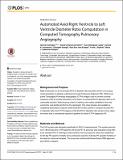Automated Axial Right Ventricle to Left Ventricle Diameter Ratio Computation in Computed Tomography Pulmonary Angiography
Author(s)
Kumamaru, Kanako K.; George, Elizabeth; Rybicki, Frank J.; Ledesma-Carbayo, Maria J.; Gonzalez Serrano, German; Jimenez-Carretero, Daniel; Rodriguez-Lopez, Sara; San Jose Estepar, Raul; ... Show more Show less
DownloadGonzalez-2015-Automated Axial Righ.pdf (2.311Mb)
PUBLISHER_CC
Publisher with Creative Commons License
Creative Commons Attribution
Terms of use
Metadata
Show full item recordAbstract
Background and Purpose
Right Ventricular to Left Ventricular (RV/LV) diameter ratio has been shown to be a prognostic biomarker for patients suffering from acute Pulmonary Embolism (PE). While Computed Tomography Pulmonary Angiography (CTPA) images used to confirm a clinical suspicion of PE do include information of the heart, a numerical RV/LV diameter ratio is not universally reported, likely because of lack in training, inter-reader variability in the measurements, and additional effort by the radiologist. This study designs and validates a completely automated Computer Aided Detection (CAD) system to compute the axial RV/LV diameter ratio from CTPA images so that the RV/LV diameter ratio can be a more objective metric that is consistently reported in patients for whom CTPA diagnoses PE.
Materials and Methods
The CAD system was designed specifically for RV/LV measurements. The system was tested in 198 consecutive CTPA patients with acute PE. Its accuracy was evaluated using reference standard RV/LV radiologist measurements and its prognostic value was established for 30-day PE-specific mortality and a composite outcome of 30-day PE-specific mortality or the need for intensive therapies. The study was Institutional Review Board (IRB) approved and HIPAA compliant.
Results
The CAD system analyzed correctly 92.4% (183/198) of CTPA studies. The mean difference between automated and manually computed axial RV/LV ratios was 0.03±0.22. The correlation between the RV/LV diameter ratio obtained by the CAD system and that obtained by the radiologist was high (r=0.81). Compared to the radiologist, the CAD system equally achieved high accuracy for the composite outcome, with areas under the receiver operating characteristic curves of 0.75 vs. 0.78. Similar results were found for 30-days PE-specific mortality, with areas under the curve of 0.72 vs. 0.75.
Conclusions
An automated CAD system for determining the CT derived RV/LV diameter ratio in patients with acute PE has high accuracy when compared to manual measurements and similar prognostic significance for two clinical outcomes.
Date issued
2015-05Department
Madrid-MIT M+Vision Consortium; Massachusetts Institute of Technology. Research Laboratory of ElectronicsJournal
PLOS ONE
Publisher
Public Library of Science
Citation
Gonzalez, German, Daniel Jimenez-Carretero, Sara Rodriguez-Lopez, Kanako K. Kumamaru, Elizabeth George, Raul San Jose Estepar, Frank J. Rybicki, and Maria J. Ledesma-Carbayo. “Automated Axial Right Ventricle to Left Ventricle Diameter Ratio Computation in Computed Tomography Pulmonary Angiography.” Edited by Diego Fraidenraich. PLoS ONE 10, no. 5 (May 22, 2015): e0127797.
Version: Final published version
ISSN
1932-6203